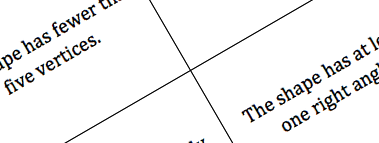What am I?
Can you draw the shape that is being described by these cards?
Problem

This challenge is designed to be worked on with a friend or in a small group.
You will need to print off and cut out the six cards from this sheet.
Can you use the information on the cards to draw the one shape which is being described?
Did you need all the information that was given? Why or why not?
Getting Started
Can you narrow down some of the shape's characteristics from the cards?
How are you keeping track of what you know so far?
Student Solutions
Thank you to everybody who sent us their ideas about what the shape could be.
Raphael and Priyam from Green Lane Primary in the UK shared their reasoning with us:
The first card we turned over said the shape had 'Exactly two lines of symmetry'. A rectangle and an oval are the only shapes with two lines of symmetry. Next we got 'Fewer than five vertices', this didn't help much because both shapes have fewer than fiver vertices. The next card said it had 'More than three sides', this meant it was a rectangle as an oval is a continuous shape and doesn't have any sides.
Well done for narrowing down the possibilities each time you drew a card! Raphael and Priyam think they have found the shape using only the information on three cards. I wonder if there were any other shapes it could have been using the information on those cards? Are there any other shapes with two lines of symmetry that Raphael and Priyam didn't think of?
Freya from Millbrook Primary in the UK looked at all of the cards and agreed with Raphael and Priyam:
The answer to What Am I is a rectangle.
I wonder if Freya could have worked that out using fewer than six cards?
If you have any other ideas about what the shape might be, or if you think not all of the cards are helpful, we would love to hear from you. Email us to share your ideas with us.
Teachers' Resources
Why do this problem?
This activity will help to consolidate learners' understanding of properties of 2D shapes. In order to tackle the problem, they will be comparing different 2D shapes, whether this be by visualising, by drawing, or using practical resources. It could be a useful assessment task.
Possible approach
Give pairs or small groups copies of the cards and simply explain that their task is to draw the shape that is being described. Try not to say anything more at this stage. Stand back and observe the children as they begin the task.
As you move around the room, watch out for those who have an organised approach. Perhaps they are discussing each card in turn and agreeing what it tells them. Perhaps they have noticed some cards which together help narrow down the possibilities. Bring the class together to share thoughts so far (a mini-plenary) which will help some children 'get off the ground' and others by giving them chance to articulate their ideas.
Having given more time for them to complete the task, the plenary could focus on whether all the information was needed. Were there any cards that were superfluous? Which ones? Why?
Key questions
What does this card tell you about the shape?
What do we know now?
How are you keeping track of what you know so far?
Possible extension
Some learners might relish the challenge of creating their own version of this task. You may wish to stipulate that there must be one solution, or perhaps you'd like them to create a task which has two or more possible outcomes. Of course, once a new activity is completed it must be tried out!
Possible support
You could give some children a sheet with some possible shapes on it, one of which is the solution. That way, the task becomes one which involves only comparing and contrasting, rather than creating.
